
Our Lady of China, the Great Mother, also known as Our Lady of Donglü, is a Roman Catholic title of the Blessed Virgin Mary associated with a reputed Marian apparition in Donglü, China in 1900.

Our Lady of Solitude of Porta Vaga also known as the Virgin of a Thousand Miracles is a Roman Catholic Marian title of Mary, mother of Jesus, based on the Marian apparitions reported in 1667 by a Spanish soldier during a night storm when he watched over the gates of Porta Vaga, later on the next day the icon was discovered in the seashore of Cañacao bay. The Virgin of Soledad is a venerated Marian icon associated to the Our Lady of Solitude. The province of Cavite and the city of Cavite consider her as its patroness.
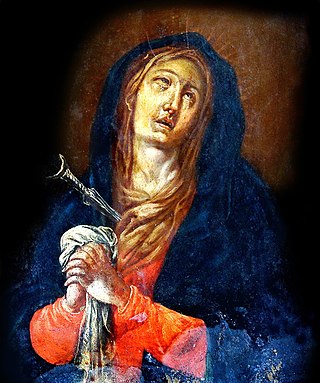
Our Lady of Sorrows of Turumba is a Marian title, a venerated Marian icon and image associated to the Our Lady of Sorrows, The town of Pakil in the province of Laguna considers her as its patroness.

Our Lady of Manaoag is a Roman Catholic title of the Blessed Virgin Mary venerated in Manaoag, Pangasinan, the Philippines. The sacred statue is referred to as Apo Baket in the native language of local devotees.

The Parish of the National Shrine of Our Lady of Fatima is a Roman Catholic parish church and national shrine in the Diocese of Malolos in the Philippines. It serves as a Philippine apostolate of Our Lady of Fatima in Fátima, Portugal, which is recognized by the Roman Catholic Church in the Philippines. The shrine is located near the Our Lady of Fatima University campus in Marulas, Valenzuela City in Metro Manila, Philippines. The shrine is one of the three major pilgrimage sites in the Diocese of Malolos, with the National Shrine of St. Anne in Hagonoy and the National Shrine of Divine Mercy in Marilao as the other sites.

Our Lady of Piat is a 16th-century Roman Catholic icon of the Blessed Virgin Mary enshrined in a minor basilca situated in Piat, Cagayan, Philippines. It is the town's and the province's patroness and is one of the most venerated Marian images of Mary in the Philippines, referred to as the "Mother of Cagayan".

The Our Lady of Guidance is a 16th-century image of the Blessed Virgin Mary depicted as the Immaculate Conception and widely venerated by Filipinos. The wooden Black Madonna is considered the oldest extant Marian statue in the Philippines. Locally venerated as patroness of navigators and travelers, the image is enshrined at the Ermita Church in the city of Manila.

Our Lady of Peace and Good Voyage, also known as Our Lady of Antipolo and the Virgin of Antipolo, is a seventeenth-century Roman Catholic wooden image of the Blessed Virgin Mary as venerated in the Philippines. This Black Madonna is enshrined in Antipolo Cathedral in the Sierra Madre mountains east of Metro Manila.

Our Lady of the Most Holy Rosary – La Naval de Manila is a venerated title of the Blessed Virgin Mary associated with the same image in the Philippines. Pious believers believe that the Virgin's intercession under this title helped to defeat the invading forces of the Protestant Dutch Republic during the Battles of La Naval de Manila in 1646.

Our Lady of the Good Event of Parañaque (Spanish: Nuestra Señora del Buen Suceso de Parañaque; Filipino: Ina ng Mabuting Pangyayari ng Parañaque is the name of a statue of the Madonna and Child enshrined in St. Andrew's Cathedral in Parañaque, Philippines. The original Spanish name is often incorrectly rendered in English as Our Lady of Good Success due to the superficial similarity between the Spanish word "suceso" and the English false friend "success."

The St. Peter of Alcantara Parish Church, designated as the Diocesan Shrine of Nuestra Señora de los Dolores de Turumba, is a Roman Catholic church in Pakil, Laguna, Philippines. It is under the jurisdiction of the Diocese of San Pablo and enshrines the Our Lady of Turumba painting.

The Archdiocesan Shrine of the Blessed Sacrament, also known as the Our Lady of the Pillar Church or simply the Santa Cruz Parish, is a Mission Revival Roman Catholic parish church in the district of Santa Cruz, Manila, Philippines. It was built when the arrabal (suburb) of Santa Cruz was established by the Jesuits in the early 17th century. The church had undergone many repairs and reconstruction, with the last reconstruction done in the 1950s.
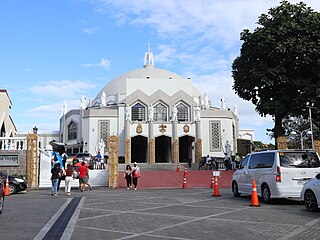
The International Shrine of Our Lady of Peace and Good Voyage, popularly known as the Antipolo Cathedral and alternatively known as the Immaculate Conception Parish, is a Roman Catholic cathedral in Antipolo, Philippines. It enshrines a venerated Black Madonna image of the Blessed Virgin Mary under the title of Our Lady of Peace and Good Voyage, and serves as the seat of the Bishop of Antipolo.
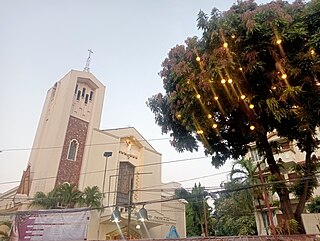
Sampaloc Church or the Archdiocesan Shrine of Our Lady of Loreto is a Roman Catholic Church located along Figueras Street in the district of Sampaloc in the City of Manila. The church is named after and dedicated to the Virgin Mary and her pilgrimage site in Loreto, Italy where tradition states as the site where the Mary's house was relocated.
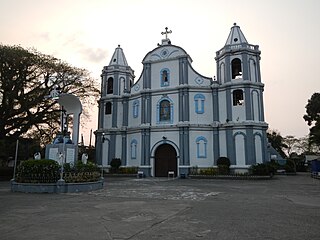
Saint Catherine of Alexandria Parish Church, also known as the Shrine of Our Lady of Namacpacan and Namacpacan Church, is a Roman Catholic church located in Luna, La Union, Philippines under the jurisdiction of the Diocese of San Fernando de La Union. Once called Luna Church, its titular is Saint Catherine of Alexandria. Built in 1690, it is also known as the shrine for the image of Our Lady of the Immaculate Conception of Namacpacan.
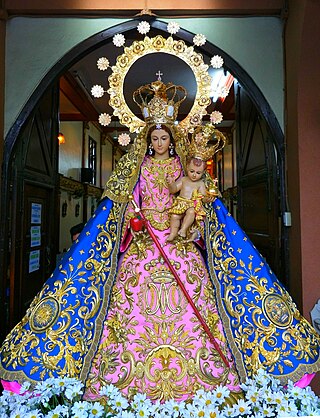
Our Lady of Aránzazu and is a Roman Catholic title of the Blessed Virgin Mary.

Our Lady of Consolation or Mary, Comforter of the Afflicted is a title of the Blessed Virgin Mary venerated in the Catholic Church.

The National Shrine and Parish of Our Lady of Mercy is a Roman Catholic church under the Diocese of Novaliches in the Philippines. It is the oldest parish in the diocese, established in 1856 by the Augustinian missionaries from Spain.

The Our Lady of the Visitation of Guibang, is a 20th-century Roman Catholic icon enshrined in the town of Gamu in the province of Isabela, Philippines. It is considered to be one of the most venerated Marian images in northern Philippines. The statue was Episcopally Crowned by the Most Rev. Carmine Rocco, Papal Nuncio to the Philippines on 26 May 1973. As closing of the Diocesan Marian Congress of that same year. The Coronation was held at St. Ferdinand College, beside the St. Ferdinand Cathedral in Ilagan, Isabela.

The Diocesan Shrine and Parish of Our Lady of the Abandoned, commonly known as the Church of Marikina, is a Roman Catholic church in Marikina, the Philippines. The church enshrines one of several images of the Madonna and Child venerated as miraculous, which has received a Pontifical decree of coronation.






























